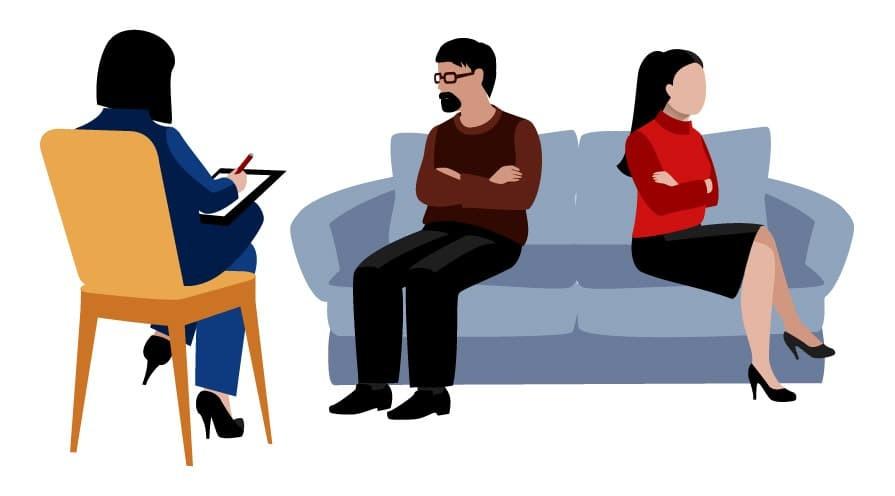
Guest blog by Samantha McGovern, LCPC, CRSS
Are you considering starting couples therapy and are doing some research about the latest and greatest approach to couples therapy? If so, you might have seen something about “Emotion-Focused Therapy.” EFT is the American Psychological Association’s “gold standard” for couples therapy. EFT research indicates that in 70-75% of cases, couples move from distress to recovery and 90% report significant improvement. But just what is Emotion-Focused Therapy?
Emotion Focused Therapy (EFT) is a well-researched, experiential, humanistic approach to psychotherapy based on attachment theory. The model prioritizes emotion and emotion regulation as it shapes individual experience and relationship interactions.
Emotion-Focused Therapy was originally developed by psychologists Sue Johnson and Les Greenberg in the 1980s for couples therapy (Emotion Focused Couples Therapy, or EFCT). However, this approach is also used for individuals with Emotion-Focused Individual Therapy, or EFIT. In addition, Emotion Focused Family Therapy, or EFFT is used for families.
The role of emotion is given priority across all three modalities (EFIT, EFCT, and EFFT). This is because of emotion’s powerful role in creating inner experience and motivation as well as key interactional patterns in relationships. Emotion links and organizes our core experience and interaction. Emotionally Focused Therapy is often used with clients dealing with depression, anxiety, and PTSD.
Emotion-Focused Therapy is typically a short-term (8-20 sessions), structured approach. However, the length of treatment varies for each individual, couple, or family and it can also be a long-term treatment.
Related Reading: 3 Ways Childhood Trauma Can Affect Your Adult Relationships
What is Attachment Theory?
As mentioned earlier, EFT is rooted in attachment theory, which was developed by British researcher John Bowlby. Attachment theory tries to explain the phenomenon of human bonding in relationships. There are ten core tenets of attachment theory:
- Attachment is an innate, motivating force. Seeking and maintaining connections with significant others is an innate, primary motivating force in human beings across the lifespan.
- Secure dependence complements autonomy. Research suggests that secure attachments with others actually help to foster independence.
- Attachment offers a safe haven. The presence of attachment figures in our lives provides comfort and security, while the absence of attachment figures triggers distress.
- Attachment offers a secure base. We can explore on our own, but the knowledge that we can come back to the secure base is empowering.
- Accessibility and responsiveness build bonds. Trust that engagement will be there when needed is crucial for secure attachment.
- Fear and uncertainty activate attachment needs. Attachment to others is our primary defense against feelings of helplessness and meaninglessness.
- The process of separation distress is predictable. When attachment behaviors fail to provide responsiveness and comfort, a predictable sequence occurs in the one seeking attachment: a process of angry protest, clinging, depression, and, finally, despair. This sequence culminates in detachment in the relationship.
- There are some insecure forms of engagement. These forms or “styles” include anxious attachment, avoidant attachment, and anxious/avoidant.
- Attachment involves working models of self and others. For example, securely attached people who believe others will be responsive when needed also tend to have a working model of others as dependable and trustworthy.
- Isolation and loss are inherently traumatizing. Deprivation, loss, abandonment, and rejection by those we need the most have an enormous impact on us.
Emotion-Focused Therapy Steps
When working with an Emotion-Focused Therapy (EFT) clinician, the first step in the process typically will be to identify the Protection Strategies being used by each party. These strategies combine to create one of two Negative Interactional Cycles:
- Hyperactivation: aka Pursue – This cycle dials up the danger signal (hyperarousal). The individual is vigilant for connection, and demands, clings, coerces, controls, and is overdependent on another. Hyperactivation happens when we have past experiences of others responding to us, but the responses have not been consistently safe and secure.
- Deactivation: aka Withdraw – This cycle downregulates need and connection (hypoarousal). The individual flees, avoids, inhibits, suppresses, and dismisses their own and other’s signals and needs. Deactivation occurs when we have learned that it is unsafe to go to others with our feelings, because they do not respond or because the response is negative.
In Emotion-Focused Therapy, the focus is on the here and now. Once the cycles are identified and tracked, the underlying primary emotions and attachment needs are uncovered. Each person is helped to own their position.
In stage two, Emotion-Focused Therapy focuses on restructuring the bond and changing interactions. Each partner owns their emotional experience of the relationship. Acceptance of the other partner’s experiences are promoted, and the expression of needs and wants is facilitated. This leads to new bonding events.
In the final stage of EFT, the therapy aims to consolidate and integrate learning through promoting new solutions to old relationship issues. This creates new positions of closeness.
The EFT Tango
In each session, the process being utilized is called the “EFT Tango.” Sue Johnson, the main developer of EFT, coined this term using dance as a metaphor for the relationship. Our emotions are the music that guides the dance of our relationships. When we are not attuned to one another, we are not listening to each other’s music. This leads to stepping on each other’s toes and tripping over one another.

Throughout the EFT process, you will work to identify your primary emotions and needs, learn to communicate them effectively, and provide support to one another in that process. In turn, this allows for corrective emotional experiences that help you de-escalate heightened experiences and respond more effectively to one another.
The goals of Emotion-Focused Couples Therapy are for you to have a secure bond (what John Bowlby would refer to as “a safe haven”) in your relationship, a secure base, and a more coherent narrative of your own relationship history. Additional goals are for you to have more emotional balance (responding to the environment versus reacting) and for you to reach out for your needs to be met from an emotionally vulnerable place through sending clear signals to your partner and responding with comfort. You can find an EFT therapist near you by searching the member registry.
Therapists at Life Care Wellness offer individual, couples, and family therapy, including EFT. Please contact us so that we can help determine which type of service or services may be most beneficial to you and your loved ones. We have office locations in Glen Ellyn, Chicago (Jefferson Park), and Sycamore.
Samantha McGovern uses a holistic approach in her work, and her goal is to assist you in reaching your ideal functioning in the 8 dimensions of wellness (emotional, physical, occupational, social, spiritual, intellectual, environmental, and financial). Her passion is providing therapy to individuals of all ages, to couples, and to families. Sam provides services in English and Spanish, and she sees clients in the Glen Ellyn office as well as by telehealth.
Reference:
Johnson, Susan M. 2003. Attachment Processes in Couple and Family Therapy. New York: The Guilford Press.





